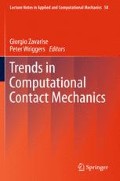Abstract
Nearly all structural problems deal to some extend with interacting bodies [1]. In consequence, contact between these bodies is one of the most often occurring problems in modelling.On the other hand, many contacts are either neglected in modelling or assumed to be represented by appropriate boundary conditions. Today most of the simulation codes used in structural mechanics allow to model contact. In consequence there is a need to qualify more users to apply contact models in everyday simulation practice. Modelling contact implies to consider the appropriate setting of the available contact parameters. Using the standard values proposed by the codes or unqualified selection of parameter combinations may produce simulation results which are either poor or even misleading. To stimulate the discussion about contact modelling some of the aspects to be considered and their non-unique consequences are discussed.
Choosing qualified element types surely will influence significantly the simulation velocity and quality. Adapting meshes to the current state of the problem may improve speed and quality essentially, but mapping the analysis results from old meshes to the new ones may cause loss of local quality. Reduced integration helps to speed up the computing time and avoid numerical stiffness, but the stress results are less qualified. Artificial stiffness introduced to prevent misleading effects like hourglasing produces potential sources of numerical errors.
The ways to detect and release contact in time and space influence significantly the course of the analysis. Simple approaches yield fast responses at the price of incorrect penetrations and incomplete definitions. Qualified algorithms may converge only after large numbers of recycles and time step reductions, so acceptable response times may not occur. Friction models suffer from the uncertainty of data and the large scatter of their input values, especially in transitions of stick to slip, high speed sliding and lubrication. The decision whether to use explicit or implicit time integration is not easy do be made in many cases.
A qualified discussion of the interaction of the parameters in contact analysis will certainly not yield a simple scheme applicable in all cases required to be considered in structural simulation. Users will be faced with problems where the ideas they have been applying successfully in many studies fail, do not converge in appropriate time or even come up with misleading results without indicating the potential danger. So the most important parameter in engineering contact analysis is the experience of the people running the jobs. Some application examples underline the problems mentioned and sketch solution proposals for some parameter configurations. Critical regions are defined, work arounds proposed and experiences presented. Small parameter changes may cause large changes in system response. In consequence for contact problems robustness studies, indicating the sensitivity of the physical and numerical parameters should be performed.
In any case the qualification and care of the analyst applying contact methods in engineering remain the most important tools to solve contact problems successfully and to learn about the interaction of structures.
Access this chapter
Tax calculation will be finalised at checkout
Purchases are for personal use only
Preview
Unable to display preview. Download preview PDF.
References
Steinbuch, R.: Remarks on the Engineering Treatment of Nonlinear Simulation Problems. St. Petersburg, Russia (2003)
Kammler, G., Mauch, G., Steinbuch, R.: Automatische Neuvernetzung stark deformierter Strukturen. Berichtsband Des MARC-Benutzertreffens, München (1992) (in German)
Bogenschütz, H., Mohrhardt, B., König, H.G., Steinbuch, R.: Numerical analysis of the pedestrian-car accident. In: Proceedings of the 1st European MARC- Users Conference, Düsseldorf (1995)
Haak, T., Mück, M., Schultz, O., Steinbuch, R.: On the influence of manufacturing on the load carrying capacity of metal structures. In: Proceedings of the CADFEM Users’ Meeting 2008, Darmstadt (October 23, 2008)
Molinari, J.F.: Multiscale modelling of nanotribology: Challenges and opportunities. Presented at ICCCM 2009, Lecce (2009)
Zavarise, G., De Lorenzis, L.: A strategy for contact problems with large initial penetrations. Presented at ICCCM 2009, Lecce (2009)
http://www.altairhyperworks.com/pdfs/product_brochuresHW_HyperForm_Web.pdf
Benson, D.J.: The history of LS-DYNA. University of California, San Diego, http://blog.d3view.com/wp-content/uploads/2007/06/benson.pdf (retrieved March 25, 2009)
Private communication with P. Vogel, Dynamore, Stuttgart, Germany
LS Dyna Keyword User Manual, Livermore Software Technolog Coperation, http://www.lstc.com
Private communication with Michael Lautsch, Lautsch Finite Elemente, Esslingen, Germany
Author information
Authors and Affiliations
Editor information
Editors and Affiliations
Rights and permissions
Copyright information
© 2011 Springer-Verlag Berlin Heidelberg
About this chapter
Cite this chapter
Steinbuch, R. (2011). Contact Modelling in Structural Simulation – Approaches, Problems and Chances. In: Zavarise, G., Wriggers, P. (eds) Trends in Computational Contact Mechanics. Lecture Notes in Applied and Computational Mechanics, vol 58. Springer, Berlin, Heidelberg. https://doi.org/10.1007/978-3-642-22167-5_18
Download citation
DOI: https://doi.org/10.1007/978-3-642-22167-5_18
Publisher Name: Springer, Berlin, Heidelberg
Print ISBN: 978-3-642-22166-8
Online ISBN: 978-3-642-22167-5
eBook Packages: EngineeringEngineering (R0)

